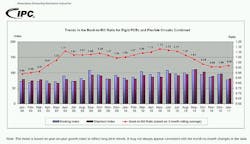IPC’s PCB industry results for January 2011 ahead over previous year
IPC — Association Connecting Electronics Industries (Bannockburn, IL, USA) has announced the January findings from its monthly North American Printed Circuit Board (PCB) Statistical Program.
PCB Industry Growth Rates and Book-to-Bill Ratios Announced
Rigid PCB shipments were up 3.7% and bookings decreased 7.7% in January 2011 from January 2010. The book-to-bill ratio for the North American rigid PCB industry in January 2011 edged up to 0.97.
Flexible circuit shipments in January 2011 were up 10.7% while bookings were up 5.3% compared to January 2010. The North American flexible circuit book-to-bill (B:B) ratio climbed above parity to 1.01.
For rigid PCBs and flexible circuits combined, industry shipments in January 2011 increased 4.3% from January 2010, as orders booked decreased 6.5% from January 2010. The combined (rigid and flex) industry B:B in January 2011 posted a slight gain to 0.97.
“Both rigid PCB and flexible circuit sales followed normal seasonal patterns in January, with rigid sales decreasing and flex sales rebounding,” says IPC president and CEO Denny McGuirk. “Orders still lag sales by a small margin. The good news is that sales in both segments are still ahead of the same month last year and the numbers look stable.”
The B:B ratios are calculated by dividing the value of orders booked over the past three months by the value of sales billed during the same period from companies in IPC’s survey sample. A ratio of more than 1.00 suggests that current demand is ahead of supply, which is a positive indicator for sales growth over the next two to three months.
Book-to-bill ratios and growth rates for rigid PCBs and flexible circuits combined are heavily affected by the rigid PCB segment. Rigid PCBs represent an estimated 89% of the current PCB industry in North America, according to IPC’s World PCB Production Report.
Sales to the Military Market
Survey participants now report the percentage of their monthly sales to the military market. In January 2011, 26% of the participating companies’ sales were to the military market. Rigid PCB producers reported that military sales accounted for 24% of their sales for the month, and flexible circuit producers reported 46% military sales. The high proportion of military sales is one of the features of the North American PCB market that sets it apart from most PCB markets in other parts of the world.
The Role of Domestic Production
IPC’s monthly survey of the North American PCB industry tracks bookings and shipments from US and Canadian facilities, which provide indicators of regional demand. These numbers do not measure US and Canadian PCB production. To track regional production trends, IPC asks survey participants for the percentage of their reported shipments that were produced domestically (i.e., in the USA or Canada). In January 2011, 81% of total PCB shipments reported were domestically produced. Domestic production accounted for 81% of rigid PCB and 86% of flexible circuit shipments in January by IPC’s survey participants. These numbers are significantly affected by the mix of companies in IPC’s survey sample, which changed slightly in January, but are kept constant through the remainder of the year.
Bare Circuits versus Assembly
Flexible circuit sales typically include value-added services such as assembly, in addition to the bare flex circuits. In January, the flexible circuit manufacturers in IPC’s survey sample indicated that bare circuits accounted for about 58% of their shipment value reported for the month. Assembly and other services make up a large and growing segment of flexible circuit producers’ businesses. This figure is also sensitive to changes in the survey sample, which may occur at the beginning of each calendar year.
Interpreting the Data
Year-on-year and year-to-date growth rates provide the most meaningful view of industry growth. Month-to-month comparisons should be made with caution as they may reflect cyclical effects. Because bookings tend to be more volatile than shipments, changes in the book-to-bill ratios from month to month may not be significant unless a trend of more than three consecutive months is apparent. It is also important to consider changes in bookings and shipments to understand what is driving changes in the book-to-bill ratio.
The information in IPC’s monthly PCB industry statistics is based on data provided by a representative sample of both rigid and flexible PCB manufacturers in the USA and Canada. IPC publishes the PCB Book-to-Bill Ratio and the PCB Statistical Program Report each month. Statistics for the previous month are not available until the last week of the following month.
SOURCE: IPC
-- Posted by Vision Systems Design
